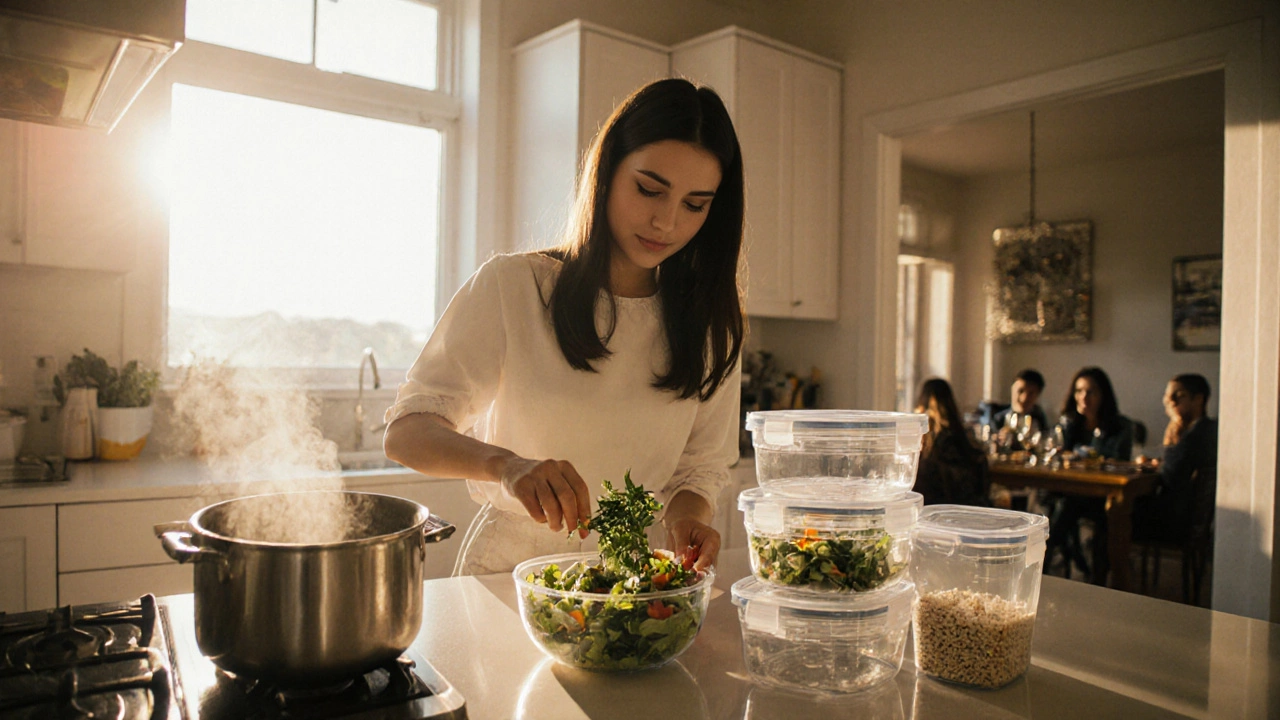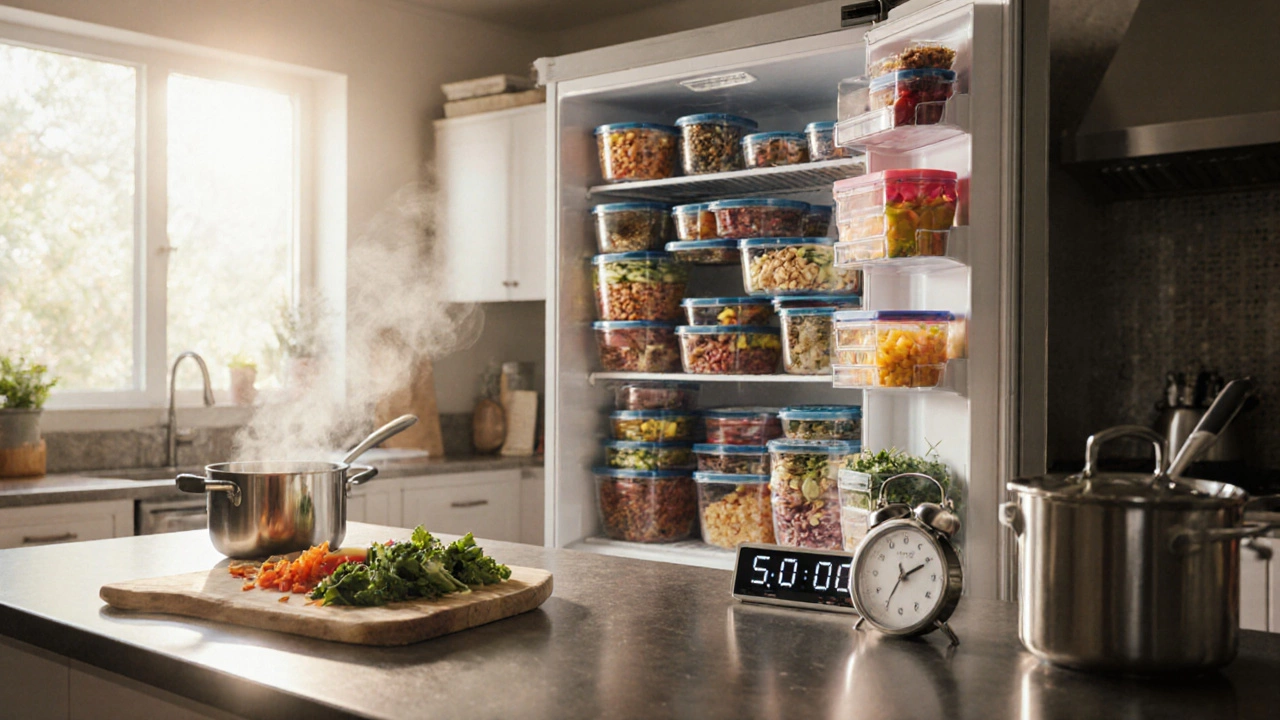Meal Prep Cons Calculator
Estimated Meal Prep Impact
Time Investment: hours
Opportunity Cost:
Total Cost:
Potential Waste: meals
Key Cons Overview
Time Investment
Typical prep takes 5–6 hours per week. With 4 weeks, that's 20–24 hours. This time could be used for other activities.
Budget Constraints
With $8 per meal and 2 people, 4 weeks = $256 total. If 30% waste, actual cost increases significantly.
Food Waste
Studies show 30% food waste in households. With 28 meals, expect 8–9 wasted meals over 4 weeks.
Nutrient Degradation
Vitamin C in cooked broccoli can lose up to 40% after 24 hours in fridge. Reheating further reduces nutrients.
Everyone loves the promise of a tidy fridge, saved dollars, and a week’s worth of healthy lunches. But before you load up a whole‑day’s worth of containers, it’s worth staring at the other side of the coin. Below we break down the biggest downsides that can turn a well‑intentioned plan into a source of stress.
Key Takeaways
- Meal prep can demand a huge upfront time chunk each week.
- Refrigeration limits and food‑safety windows may force you to waste meals.
- Sticking to the same recipes can sap flavor, nutrition, and motivation.
- Buying in bulk can spike your grocery bill if you’re not careful.
- The routine can clash with social plans and spontaneous cravings.
Understanding Meal prep is the practice of cooking and portioning meals in advance, typically for a whole week, to save time and streamline nutrition
When the idea first hits, it feels like a super‑power: you’ll never have to wonder what to eat, you control portions, and you can line‑up macro goals. Yet that super‑power comes with hidden costs that become obvious only after the first batch of containers is stacked in the freezer.
The Time Crunch: Time investment the total hours spent shopping, cooking, and packing meals for future consumption
Let’s be honest - most people think meal prep is a three‑hour Sunday job. In reality, if you’re aiming for balanced dishes, chopping veggies, cooking grains, and portioning protein can easily reach five or six hours. That’s a massive chunk of a weekend that could be spent traveling, exercising, or simply relaxing.
For busy professionals, that upfront grind can feel like a penalty rather than a payoff. The more elaborate the menu, the longer the prep, and the higher the risk that you’ll skip the session altogether, reverting to fast‑food shortcuts.
Storage Limits and Food Safety: Refrigeration space the physical capacity of a fridge or freezer to hold pre‑made meals without compromising temperature safety
Even if you have a decently sized fridge, container walls multiply quickly. A weekly plan for two people can fill every shelf, leaving little room for fresh produce or leftovers. When space runs out, you either have to cut down on the number of meals you prep or resort to stacking containers, which can cause uneven cooling.
Beyond space, every cooked item has a safe window: most dishes stay fresh for 3‑4 days in the fridge and up to 3 months in the freezer. Miss your timeline, and you’ll be tossing perfectly good food.
Waste Woes: Food waste the amount of edible food that is discarded because it spoils or is no longer wanted
Imagine you prep a batch of quinoa‑veggie bowls, only to find that after a few days the veggies turn soggy and unappetizing. The usual response is to discard the entire container. Over a month, that adds up to a sizable amount of waste, negating the eco‑friendly advantage many tout.
Studies from the United Nations show that household food waste in the U.S. averages about 30% of purchased food. Meal prep can unintentionally push you into that range if you don’t rotate menus or use proper storage techniques.
Nutrition at Risk: Nutrient degradation the loss of vitamins, minerals, and other beneficial compounds in foods over time due to exposure to heat, light, and oxygen
Cooking once and eating later means certain nutrients-especially vitaminC, B‑vitamins, and some antioxidants-diminish with each reheating cycle. If you rely on the same batch of veggies for a whole week, you might be missing out on peak nutrient levels that fresh‑cooked meals provide.
One 2023 nutrition study found that boiled broccoli loses up to 40% of its vitaminC after 24hours in the fridge, and a second reheating drops it another 15%. That’s a real drawback for anyone chasing optimal health.
Budget Blow‑outs: Budget constraints the financial limits that dictate how much money can be spent on groceries and cooking supplies
Buying in bulk sounds cheap, but the math can flip when you factor in wasted produce, extra containers, and higher-quality ingredients you need for variety. A single week of fancy protein packs and pre‑cut veggies can easily top $100 for two people.
If you’re not meticulous about price‑matching and using pantry staples, the purported savings disappear. Some people even end up spending more than they would on regular grocery trips because they feel pressured to buy larger quantities to “make the prep worth it.”
Monotony and Motivation: Culinary monotony the repetitive nature of eating the same prepared meals day after day, leading to decreased enjoyment and adherence
Eating the same chicken‑rice‑veggie combo for five days can turn meals into a chore. This boredom often leads people to abandon the routine, opting for takeout or snack binges that sabotage their original goals.
Psychologists note that variety is a key driver of satiety. When taste buds get bored, you’re more likely to over‑eat or skip meals altogether.

Social Flexibility: Social flexibility the ability to adapt meal plans to spontaneous events, gatherings, or dining out without penalty
Having a fridge full of pre‑packed lunches can make spontaneous dinner plans feel like a betrayal. Declining a friend’s brunch invitation because you’ve already spent hours on your own meals adds social friction.
That rigidity can also cause stress: you may feel compelled to eat your pre‑made meals even when a culturally significant dinner is happening, missing out on shared experiences.
Mitigating the Cons: Practical Tips
- Batch‑cook smarter, not longer: Choose recipes with overlapping ingredients to cut chopping time.
- Invest in stackable, airtight containers to maximize refrigeration space.
- Schedule a mid‑week “refresh” where you swap out stale dishes for fresh salads or soups.
- Freeze portions in individual bags to reduce food waste and simplify reheating.
- Rotate protein sources (chicken, beans, fish) every couple of weeks to keep flavor and nutrition fresh.
- Track grocery spend per week; set a hard cap to avoid budget constraints creep.
- Plan at least one “free‑choice” day where you eat out or improvise to keep social life fluid.
Quick Comparison: Common Cons vs. Simple Solutions
| Con | Impact | Mitigation |
|---|---|---|
| Time investment | 5‑6hrs/week | Prep double‑purpose ingredients (e.g., roast a whole chicken for meals and salads) |
| Refrigeration space | Overflowing fridge | Use stackable containers and freeze half the portions |
| Food waste | Up to 30% discarded | Plan a mid‑week menu edit; repurpose leftovers into soups or stir‑fries |
| Nutrient degradation | Loss of vitamins 15‑40% | Reheat only what you’ll eat; add fresh greens at serving time |
| Budget constraints | Higher grocery bill | Buy staple carbs in bulk, use seasonal veggies, track spend |
| Culinary monotony | Boredom, drop‑off | Rotate sauces, spices, and protein types weekly |
| Social flexibility | Feeling locked‑in | Reserve one “free‑choice” meal per week for spontaneous plans |
When Meal Prep Might Not Be Worth It
If any of these cons hit close to home, consider a hybrid approach. Cook a few core ingredients (like rice or quinoa) on Sunday, then build fresh meals each night using quick‑cook proteins or store‑bought rotisserie chicken. This keeps prep time low while preserving variety.
People with irregular schedules-shift workers, freelancers, or frequent travelers-often find the rigidity of full‑week prep more stressful than helpful. For them, a “mini‑prep” of 2‑3 days can strike a better balance.
Frequently Asked Questions
Is meal prepping actually cheaper than cooking daily?
It can be, but only if you stick to a strict shopping list, buy in bulk wisely, and avoid throwing away unused meals. Many people find that occasional waste and the cost of premium containers offset the savings.
How long can cooked meals stay safe in the fridge?
Generally 3‑4 days for most cooked dishes. Soups and stews may stretch to 5 days, while seafood should be eaten within 2 days. Always reheat to at least 165°F (74°C) to kill any bacteria.
Can I reduce nutrient loss when reheating?
Yes. Use gentle reheating methods like steaming or microwaving at lower power, and add fresh herbs or a squeeze of lemon right before eating to boost flavor and nutrients.
What’s the best container type for freezer storage?
Airtight, BPA‑free plastic containers or silicone bags work well. Make sure they’re labeled with the date and contents to avoid mix‑ups.
How can I keep my meals interesting?
Rotate sauces, spices, and cooking methods. A grilled chicken breast one day can become a shredded taco filling the next. Pair the same protein with different veggies, grains, and flavor profiles to keep your palate engaged.





